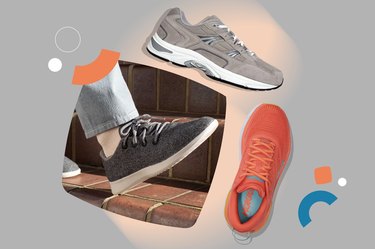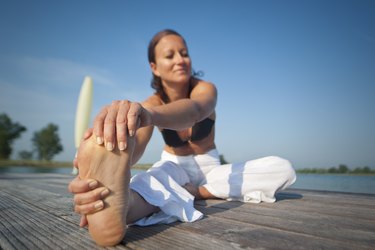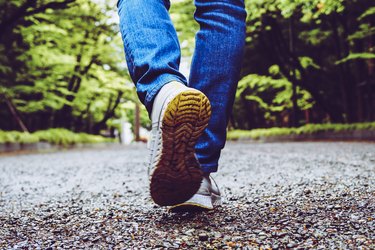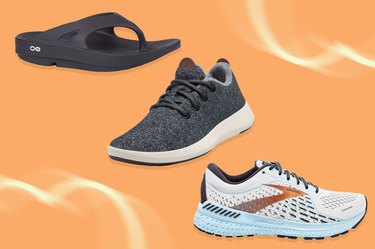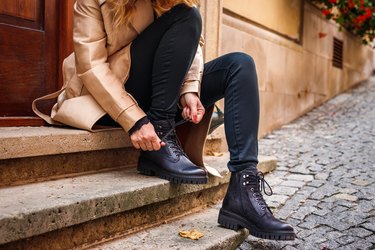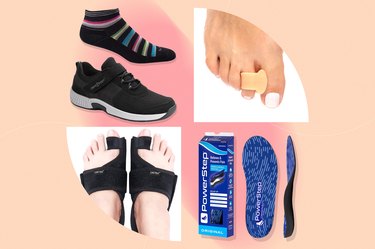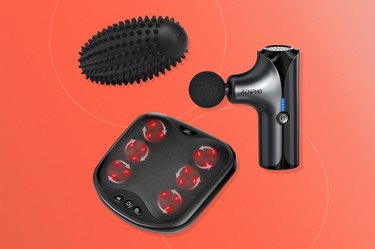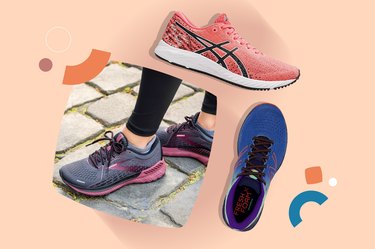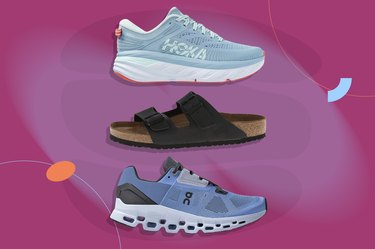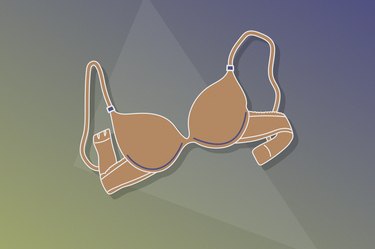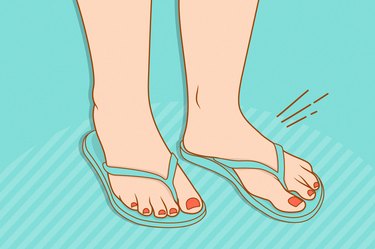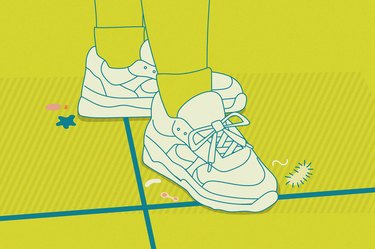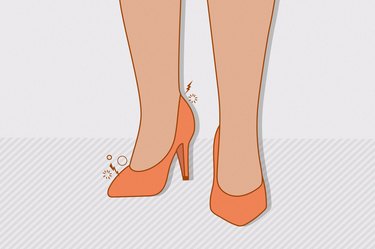
From classic pumps to skyscraper stilettos and strappy sandals, the right pair of heels can really elevate your outfit (get it?).
But they're not exactly the most comfortable shoe out there. And if you wear them all the time, are heels bad for you?
Video of the Day
Video of the Day
Here, hear from a podiatrist why you may want to wear heels less often, get tips to relieve foot pain from heels and learn how to find the most comfortable shoe for you.
9 Risks of Wearing High Heels
"From a kinetic standpoint, high heels are poorly designed, and wearing them has adverse effects on the human foot," says podiatrist Mark Mendeszoon, DPM, director of the Advanced Foot and Ankle Fellowship with University Hospitals Richmond Medical Center.
"The foot normally needs to walk heel to toe, and in order to do so it must be on a flat surface," Mendeszoon adds. "But high-heeled shoes force the foot into unusual positions and changes the biomechanics of normal walking."
That can lead to a cascade of issues, including:
1. Foot Pain
A survey from the American Podiatric Medicine Association (APMA) found that high heels are the number one cause of foot pain among those who wear them, with 71 percent of heel-wearers reporting that heels hurt their feet.
In fact, a November 2013 study in the Singapore Medical Journal found 68 percent of women with recurrent foot pain attributed their discomfort to footwear — high heels in particular. (Note: We at LIVESTRONG.com aim to avoid using gendered language like women, but we've included it here because that's the language the study authors used.)
Although any type of heels can lead to tender toes, pointy, closed-toed shoes are the biggest culprit.
And foot pain is associated with other health issues: The APMA survey found people with chronic foot pain significantly more likely to experience other health problems like back pain, joint pain and weight issues — as well as seemingly unconnected ailments like acne, poor eyesight and dental discomfort.
2. Hammertoe and Calluses
"Stuffing a rectangular-shaped forefoot into a triangular shoe will not only cause discomfort, but can also have long-term consequences," Dr. Mendeszoon says. "It actually changes the shape of the foot, causing structural bony problems."
The narrow toe bed of a high heel squeezes and cramps the toes, which can lead to a condition called hammertoe, where your toes curl under. (This may also be why your toes get numb after wearing heels, by the way.)
"Hammertoes can cause calluses to form on the tops or tips of your toes," Dr. Mendeszoon says.
The calluses are at risk of infection — especially if you try to cut or file them off — and in extreme cases can cause an infection in the bone.
3. Bunions
High heels can also trigger the development of painful bunions, where your big toe joint is out of alignment with the rest of your toe joints.
A December 2015 study in Arthritis Care & Research found that wearing high heels increased the risk of developing bunions by 47 percent, due to increased pressure on the forefoot.
"In high heels, the weight distribution across your foot is altered tremendously," Dr. Mendeszoon says. "Instead of walking heel to toe, you put most of the pressure on the ball of the foot."
Another December 2016 study in the Journal of Gerontology suggests you're more likely to develop bunions if your shoes have a narrow toe box. So, pointy stilettos are worse offenders than open-toe sandals.
4. Metatarsalgia
The ball of your foot is covered with a fat pad to protect the knuckle joints of your toes, called the metatarsal head.
"When you wear heels, your toes contract and buckle," Dr. Mendeszoon says. "As hammertoe develops and your toes start curling under, they push back on the metatarsal head."
Over time, all this pushing causes the fat pad to become displaced, so you have little to no cushion on the balls of your feet — you are essentially walking on skin and bones.
"Then, your bones become bruised and inflamed, which is a condition called metatarsalgia," Dr. Mendeszoon says. "As a result, you begin walking differently to compensate for the pain."
In most cases, resting, changing your shoes or using metatarsal pads (more on those in a minute) can relieve pain. But sometimes the condition requires surgery to realign the metatarsal bones, per the Mayo Clinic.
5. Neuromas
Neuromas are irritated nerve endings on the bottom of your feet. Putting a lot of pressure on the balls of your feet (i.e., when wearing heels) can create swelling.
"This inflammation can compress the nerves between the knuckle joints in your feet," Dr. Mendeszoon says. "Over time, the nerves can get pinched, leading to significant pain that might require physical therapy, medication, injections or even surgery."
Tip
The best shoes for neuromas have a wide toe box, arch support and cushioning under the ball of the foot.
6. Tight Achilles Tendon
High heels are a recipe for tense Achilles tendons.
"The Achilles tendon will always be contracted in a high-heel shoe," Dr. Mendeszoon says. "This can lead to stiffness, and with daily use can actually shorten your Achilles over time."
Eventually, your Achilles can even contract to the point where wearing flat shoes or going barefoot is painful, too.
"A tight Achilles tendon is the top cause of nontraumatic overuse foot and ankle conditions, including neuromas, plantar fasciitis, tendonitis and stress fractures," Dr. Mendeszoon says.
7. Posture Dysfunction
According to the PeerJ study, as high heels interfere with the natural motion of the feet, this can also change the distribution of pressure on the bottom of your feet, affecting your ankle joints and surrounding muscles and limiting your ankle's range of motion.
From there, it's a chain reaction of bad news for your entire body: You compensate for the unnatural gait by using other muscles harder and your joints differently, causing muscle imbalances in your legs.
"It has a domino effect," Dr. Mendeszoon says.
He explains that contraction of the Achilles tendon leads to more flexion in the knee, puts stress on your hip and affects the curvature of your back. The discs in your back can also lose water content, get herniated and start to compress. And your lower back can tighten up and spasm. Even your quad and hamstring muscles will be imbalanced.
"That is how you start having soft tissue problems, knee issues or tendonitis," Dr. Mendeszoon says.
Basically, heels can royally screw up your posture, from toe to head. Dr. Mendeszoon even points out that there's a link between high heel use and TMJ disorders (jaw pain).
8. Ingrown Toenails
"When shoes are too tight, your feet will begin to swell," Dr. Mendeszoon says. "This inflammation can cause your toenails to bite into the skin, eventually creating ingrown toenails that can become painful and or infected."
9. Other Injuries
A January 2016 review in BMJ Open found that high heel use is associated with a risk of injury. According to the review, stepping into stilettos regularly can increase your chance of repetitive strain injury (damage to your tissue caused by repeated movements).
Wearing heels also significantly raises your risk of fractures to the foot, leg, arm and pelvis.
"As most high heel shoes only have two points of contact balance, you are more likely to trip or fall," Dr. Mendeszoon says.
And walking with your toes lower than your heel puts your ankle in an unstable position, making you more prone to sprains.
The BMJ Open review suggests that heel wearers are particularly prone to stair injuries, as the heel can catch on the edge of the steps.
What's more, a high heel habit is associated with a higher risk of falling in older adults — even if they weren't wearing heels at the time of the tumble. The review found that the physiological toll that stepping into stilettos daily takes on your body predisposes you to falling, no matter what's on your feet.
10 Ways to Relieve Foot Pain From High Heels
Dr. Mendeszoon says ideally, you would not wear high heels in the first place.
But if you do wear heels to work (or just love a good fashion statement), these ideas may help relieve the aches and pains they can cause:
1. Stretch Your Achilles Tendon
To loosen a tight Achilles, Dr. Mendeszoon suggests one of the following moves at the end of the day.
- Towel stretch: Sit on the floor with your legs straight out in front of you. Wrap a towel around the ball of your left foot. Grab the ends of the towel and pull back towards your body. Hold for 30 seconds, then switch sides. Repeat 10 to 15 times on each foot.
- Wall stretch: Stand a couple feet away from a wall. Place both hands on the wall. Step back with your left foot and slightly bend your right knee. You will feel a stretch in your left Achilles tendon. Hold for 30 seconds, then switch sides. Repeat 10 to 15 times on each foot.
- Stair stretch: Stand on the edge of a step. Place your hands on the banister or wall for balance. Drop both heels down and hold for 30 to 60 seconds. Repeat 10 to 15 times.
- Book stretch: Sit in a chair and place a thick book on the floor in front of you. Prop the ball of your foot on top of the book and drop your heel toward the floor. Lean forward until you feel a stretch in your Achilles. Hold for 30 seconds, then switch sides. Repeat 10 to 15 times on each foot.
2. Try Foot-Mobilization Exercises
"These foot mobilization exercises break up stiffness, restore elasticity to the tendons and increase flexibility," Dr. Mendeszoon says.
- Towel scrunch: Sit in a chair and lay a towel under your foot. Keeping your heel in place, lift your toes and use them to grab the towel and draw it toward your body. Do one rep with each foot.
- Toe grabs: Spread out some small toys on the ground, such as jacks, marbles, chess pieces or Lego pieces. Place a bowl, basket or bucket on the floor nearby. Using your toes, pick up the toys from the floor and drop them in the bowl. Repeat 20 to 30 times with each foot.
3. Massage Your Feet
"Massage increases blood flow and mobilizes synovial fluid in the joints and tendons," Dr. Mendeszoon says. "This decreases swelling and loosens your muscles." (And hello, relaxation!)
Spend 10 to 15 minutes a day doing one or more of the following:
- Arch rub: Rub your fingers across your arches, using however much pressure feels good to you.
- Foot roll: Place a foam roller, frozen 20-ounce water bottle or can of veggies on the ground. Put your foot on top of it and roll back and forth.
- Scraping: Apply lotion to sore body parts — bottom of your feet, Achilles tendon, hips, etc. Sweep a scraping tool ($12.99, Amazon) in an upward motion across your achy muscles.
4. Wear Sneakers at Home
According to Dr. Mendeszoon, after about two years of daily high heel use, your body will adapt to walking with an elevated heel and wearing flat shoes can cause discomfort in your knees or hips.
To offset this unhealthy adaptation, change into sneakers or supportive flats whenever you are at home.
"Lowering your heels down might somewhat mitigate the damage," Dr. Mendeszoon says. "It allows the fibers of the Achilles to stretch and restores proper function and tensile elasticity."
6 Tips for Wearing Heels Comfortably
Whether your job requires professional ensembles (which may include heels) or you want to sport fun shoe for a night out, these ideas will help you wear high heels comfortably.
1. Wear Low Heels
According to the APMA, heels tilt your body weight forward, causing significant pressure on the front of the foot, leading to foot and posture issues.
This is true of any heel height, but heels higher than 2 inches put the most strain on your body.
So, if you must wear heels, choose a lower height to reduce these side effects. (It's worth noting that kitten heels are typically lower than one inch.)
2. Opt for Open Toe or Wide Toe
Cramming your feet into pointy, narrow stilettos can exacerbate pain and damage. Instead, choose shoes that are open-toed or have a wide toe box.
"Platforms, wedges or cowboy boots will give you height but have a wider base for walking," Dr. Mendeszoon says.
That said, the APMA points out that platforms and wedges can still throw off your balance, potentially leading to ankle rolls and falls. So stick to a pair with a lower height profile and ankle strap.
3. Add Padding
Make sure your heels have padding in the front, where pressure on your toes is greatest. Stick a metatarsal pad ($13.95, Amazon) to the bottom of your foot for added cushioning — you can also find them at many drug stores and shoe stores.
4. Wear Heels in Moderation
"If you are going to wear high heels, use them in moderation, alternating with other styles," Dr. Mendeszoon says. "Anything you can do to minimize the number of steps you take in heels will help."
For example, try wearing them only when dressing up. You can also pop your heels in a bag and lace up a pair of sneakers for your commute, then change into your heels once you arrive at your destination.
5. Avoid Peep Toe Heels
Heels that play peekaboo are kryptonite for toe health. The APMA says they can cause your toes to overlap and might press the edges of your toenails into your skin, increasing the risk of ingrown nails.
6. Find Heels That Are Podiatrist-Approved
Any high heels that have received the APMA Seal of Approval (like these picks from Zappos) will be comfortable options for standing and walking throughout your day.
If you have other food conditions you are treating, you can speak with your podiatrist about heels they would recommend.
So, How Bad Is It Really to Wear Heels All Day Long?
Sorry, fashionistas. Turns out, wearing high heels on the regular is actually pretty bad for your foot health and can cause heel, toe, muscle and tendon complications in the long run.
In fact, when we interviewed Dr. Mendeszoon, he had just completed a day in the operating room that included amputating a toe as a result of complications from years of high heel use (ouch!).
If you would like to continue donning your favorite heel styles, try wearing them in moderation, sticking with closed-toe, wide toe box heels and alternating between different styles.
And of course, if you feel any pain or complications, talk to your doctor or visit a podiatrist to get more information on diagnosis and treatment options.
- PeerJ: "Influences of heel height on human postural stability and functional mobility between inexperienced and experienced high heel shoe wearers"
- APMA: "Public Opinion Research on Foot Health and Care"
- Singapore Medical Journal: "Prevalence of nontraumatic foot pain among urban young working women and its contributing factors"
- Arthritis Care & Research: "Characteristics Associated with Hallux Valgus in a Population-Based Study of Older Adults: The Framingham Foot Study"
- Journal of Gerontology: "Epidemiology of Shoe Wearing Patterns Over Time in Older Women: Associations With Foot Pain and Hallux Valgus"
- BMJ Open: "High-heeled shoes and musculoskeletal injuries: a narrative systematic review"
- Mayo Clinic: "Metatarsalgia"
Is this an emergency? If you are experiencing serious medical symptoms, please see the National Library of Medicine’s list of signs you need emergency medical attention or call 911.

